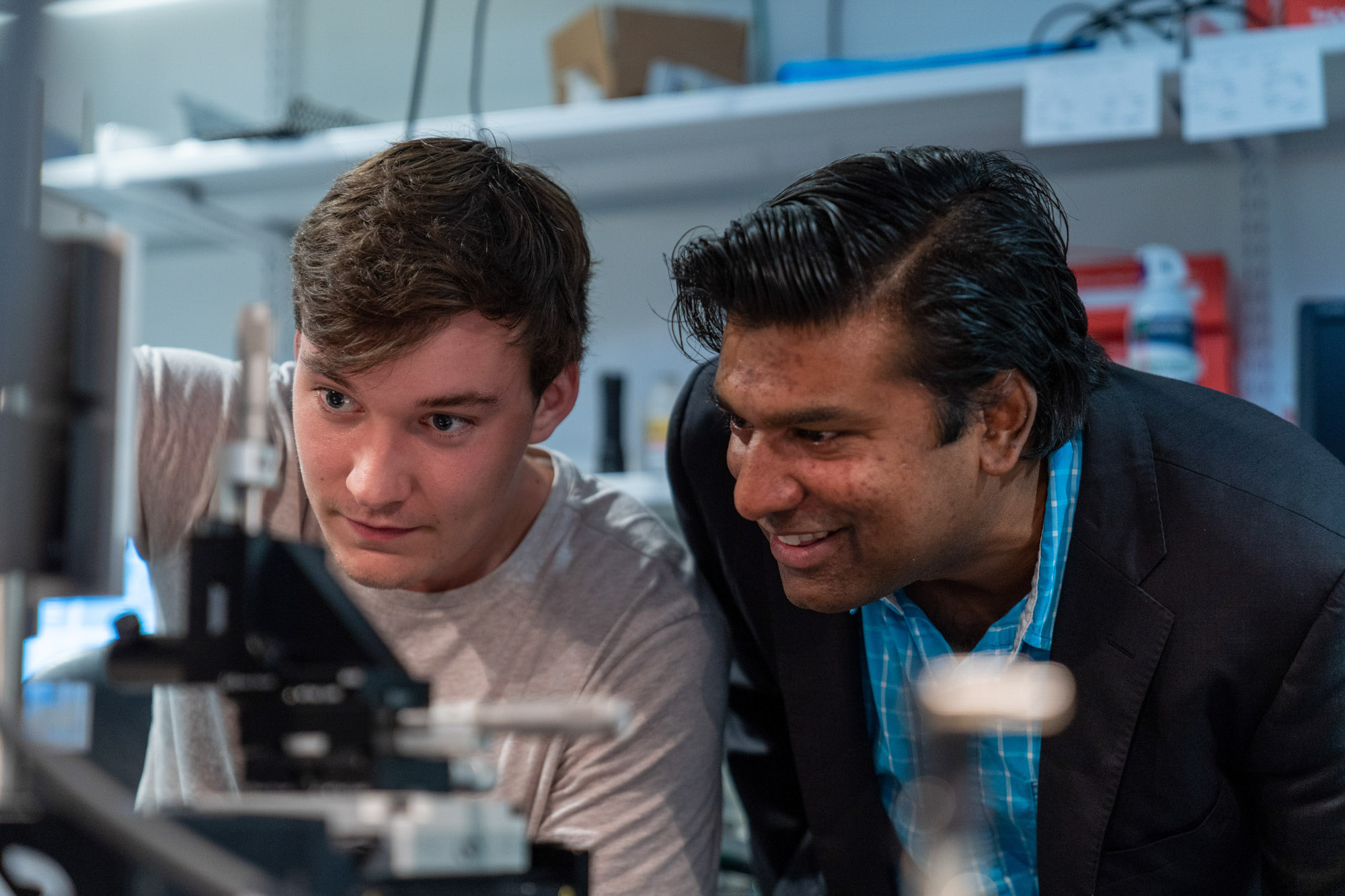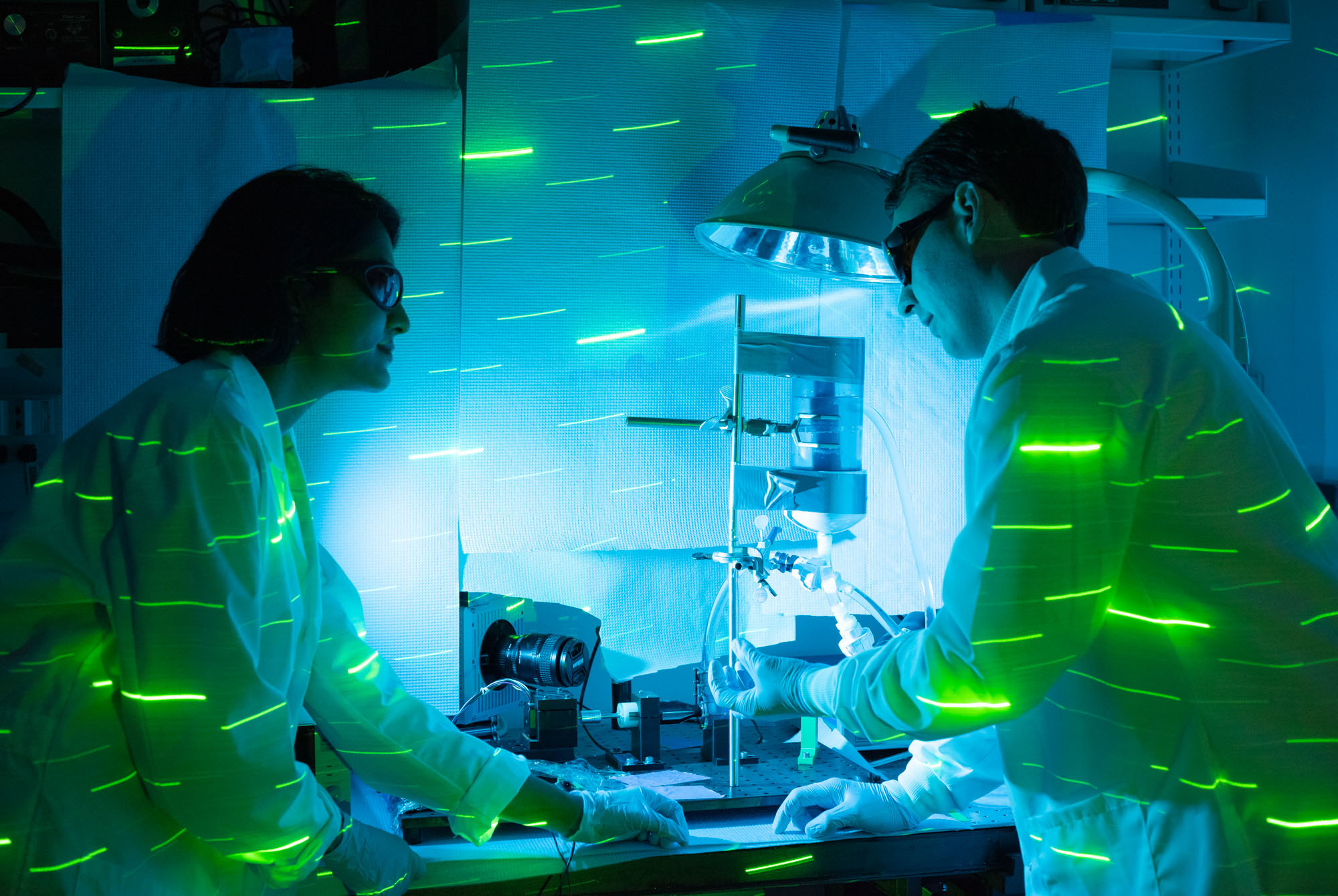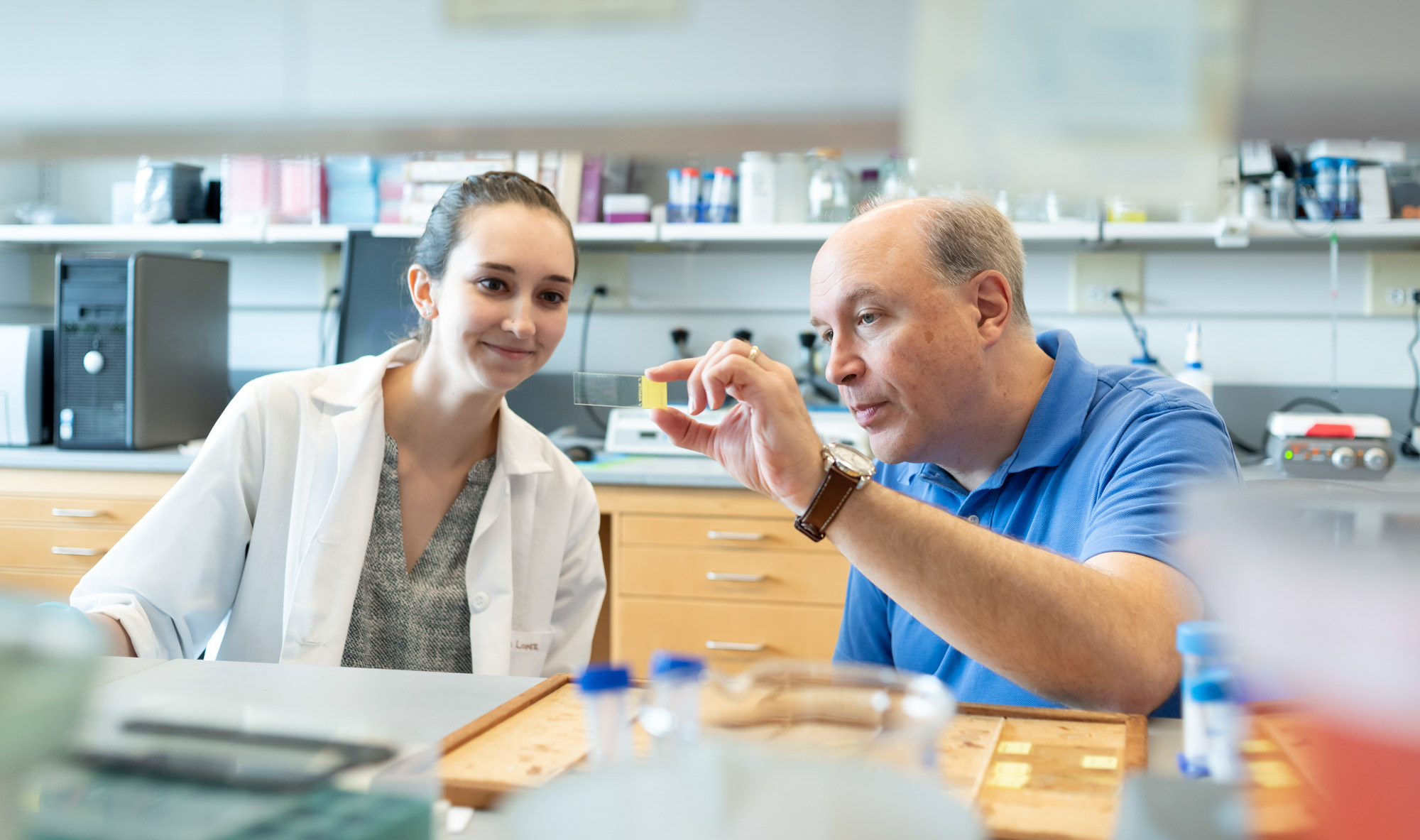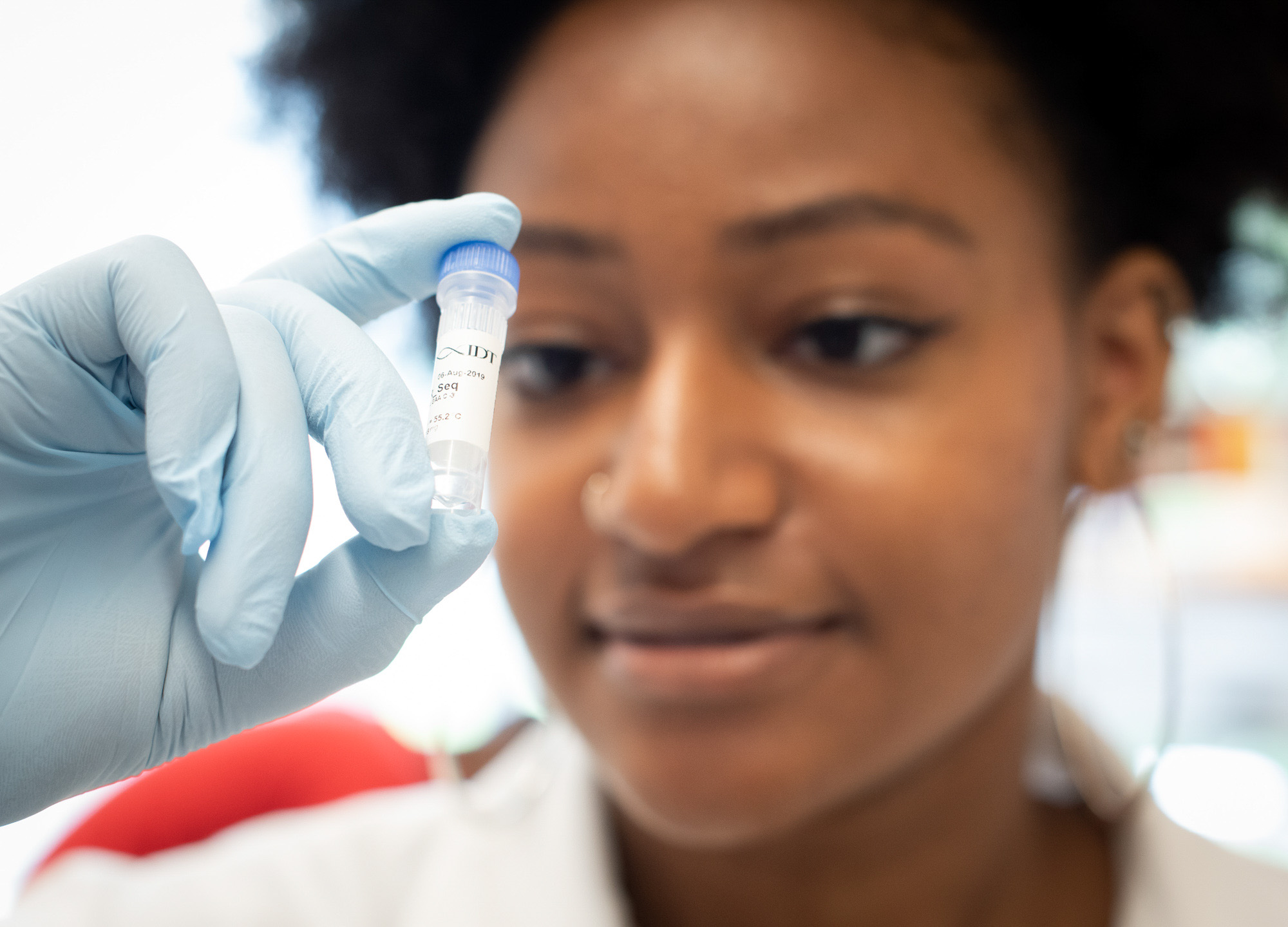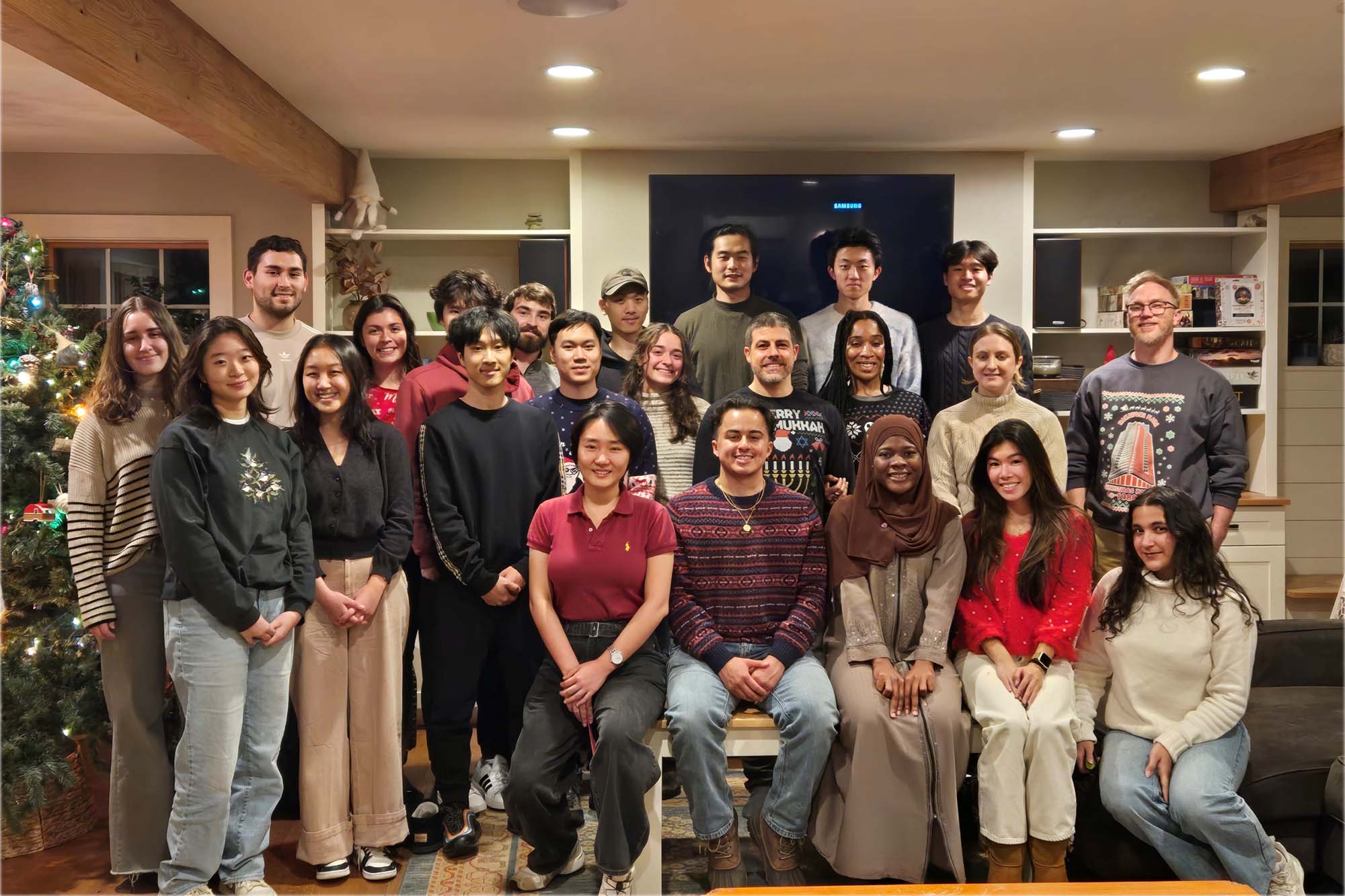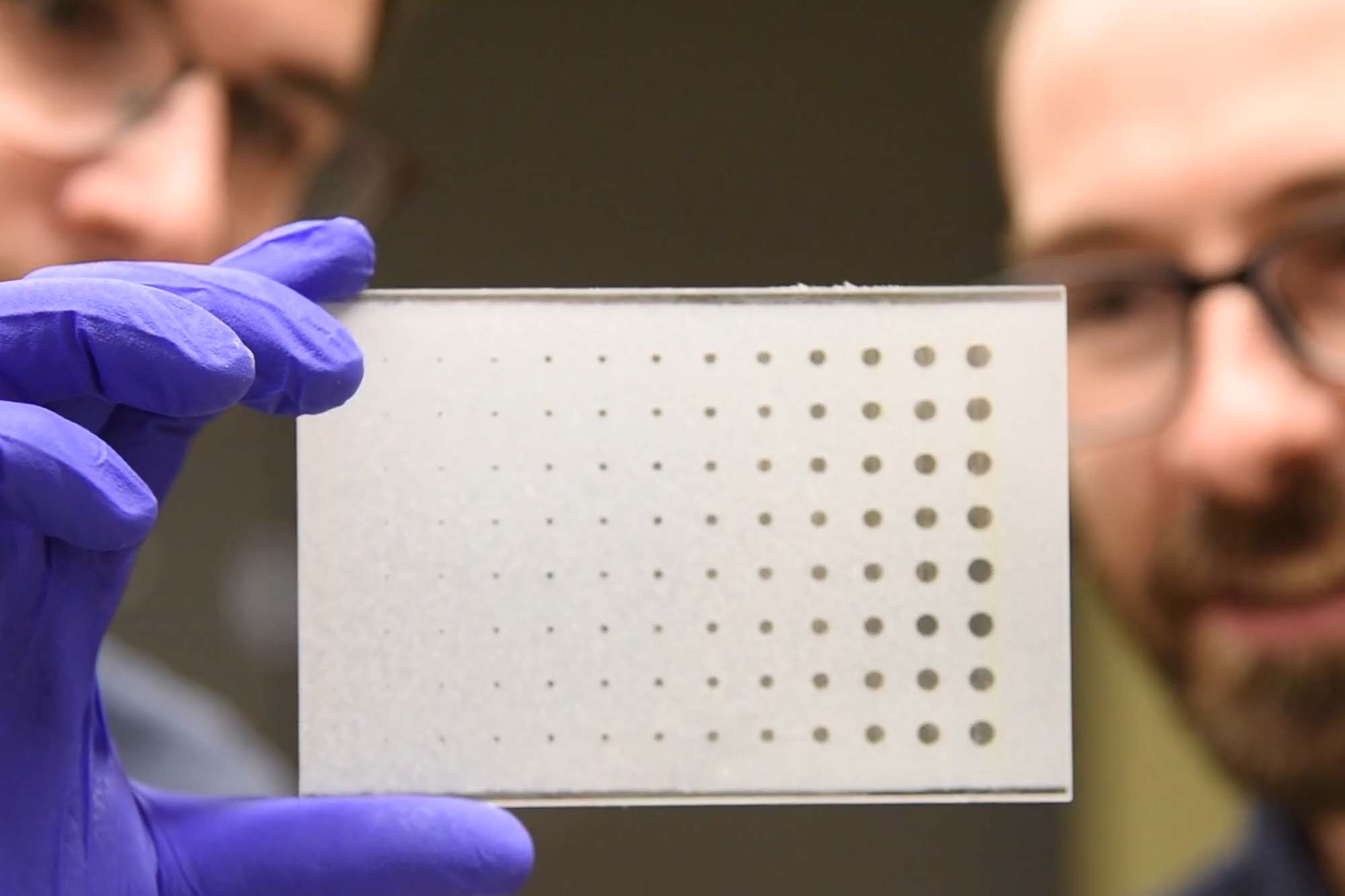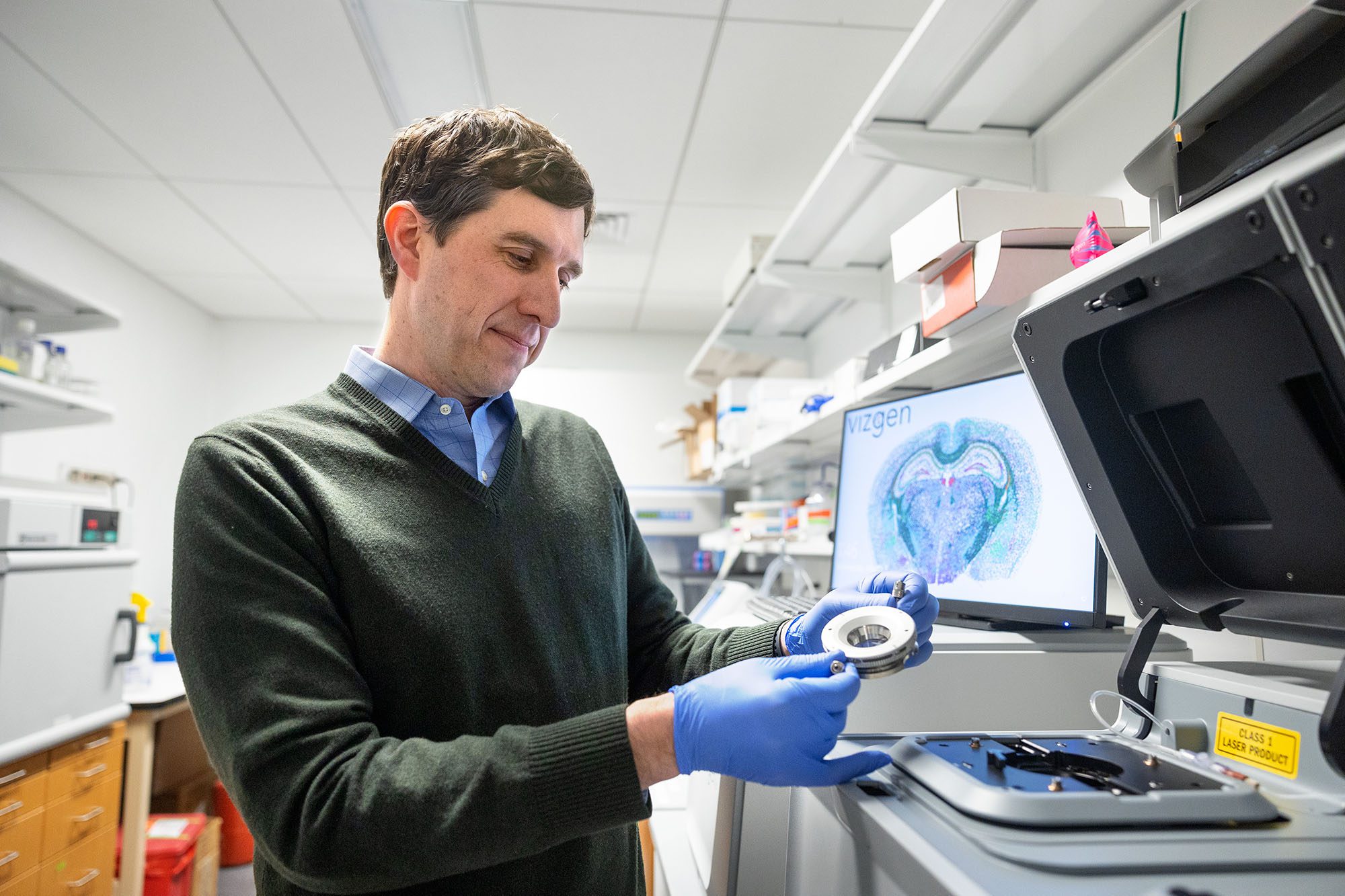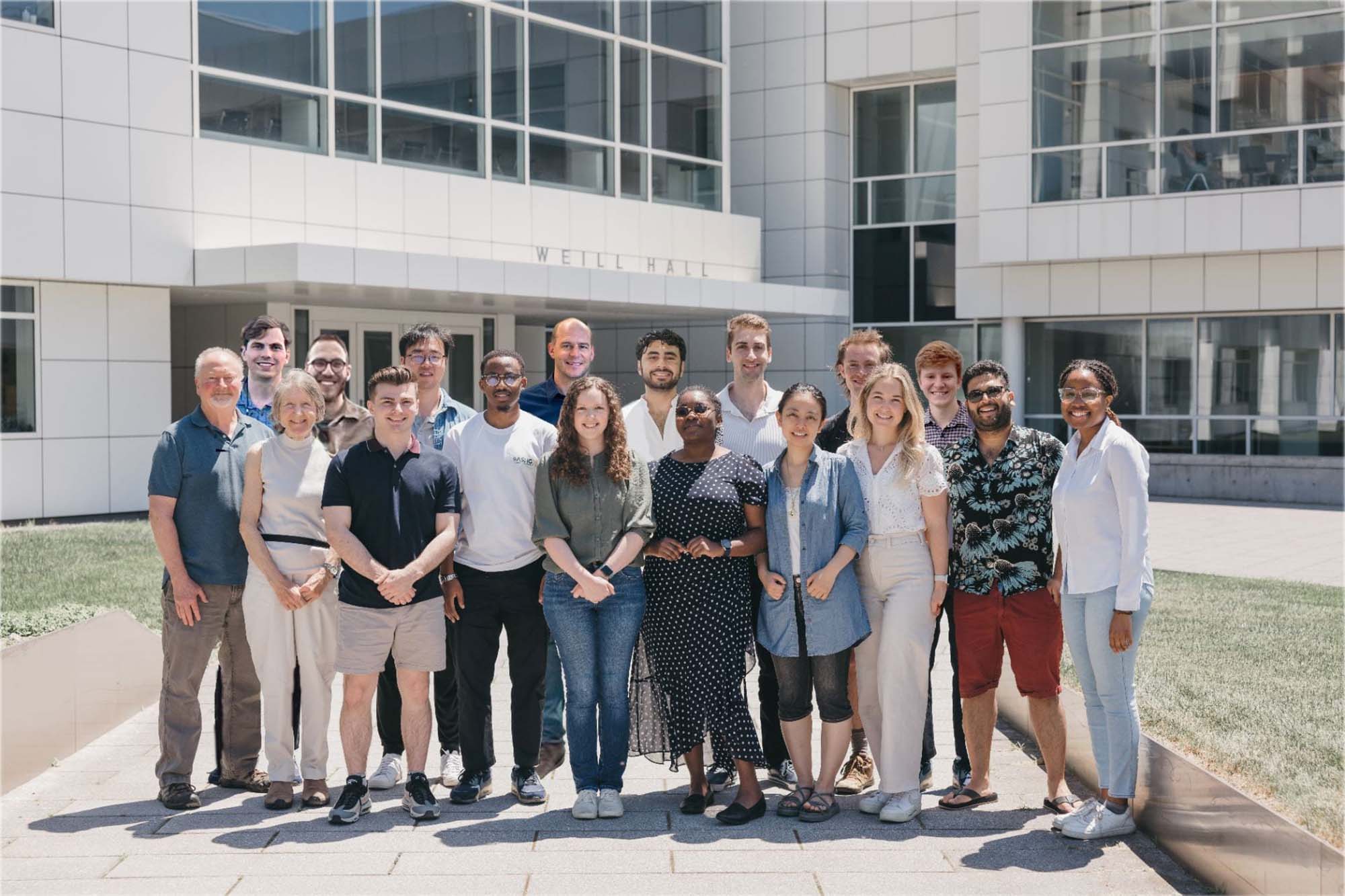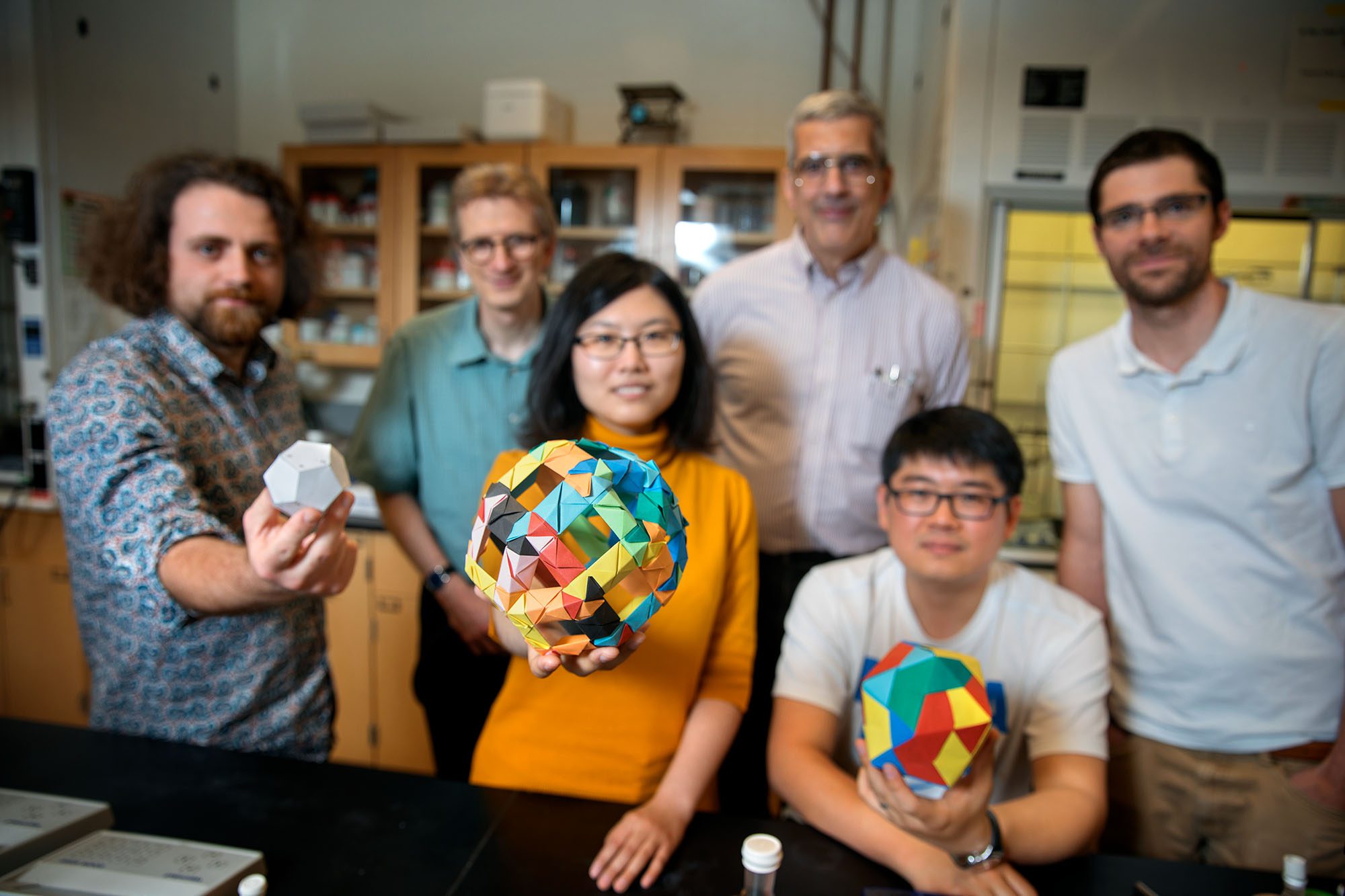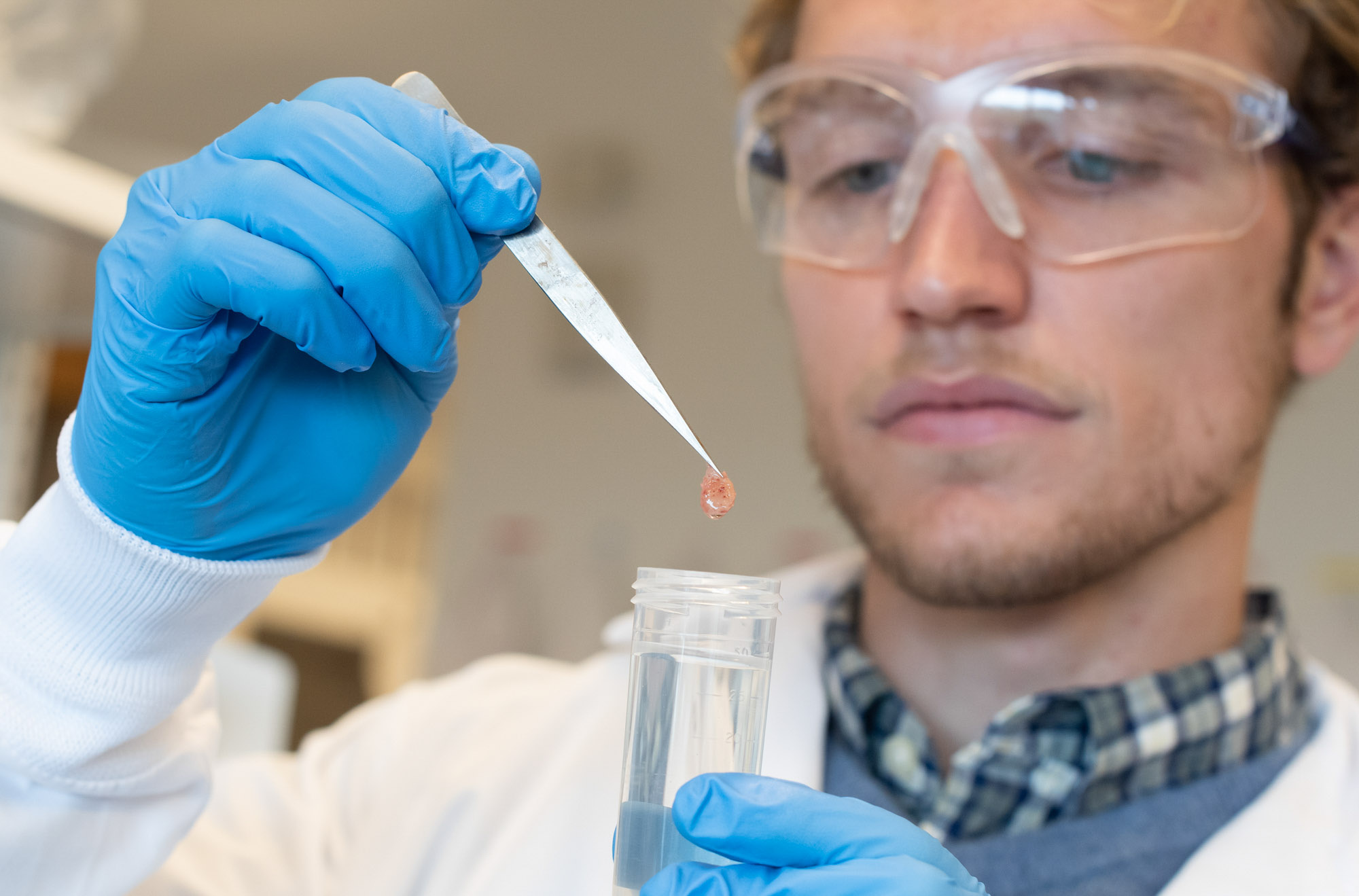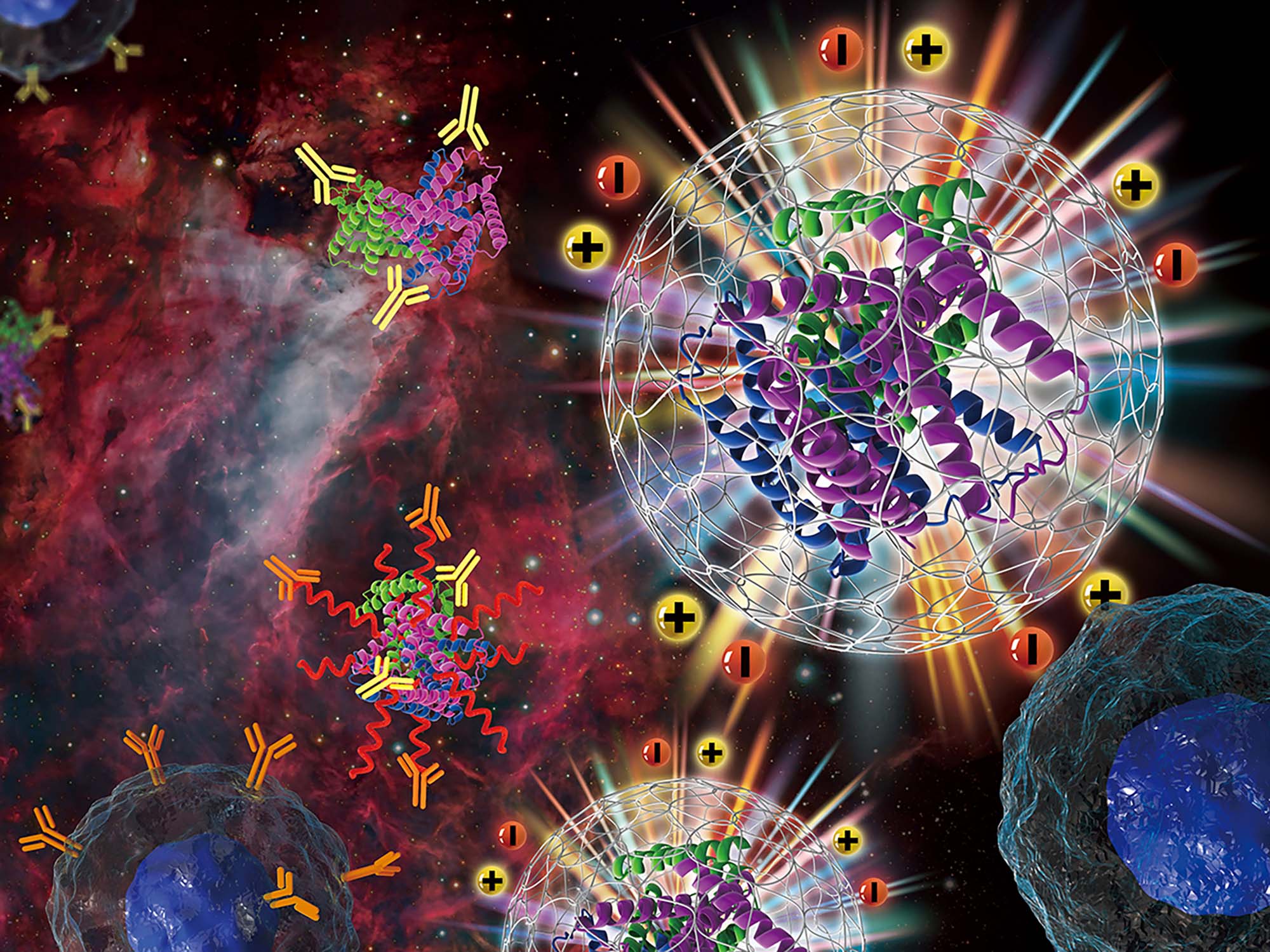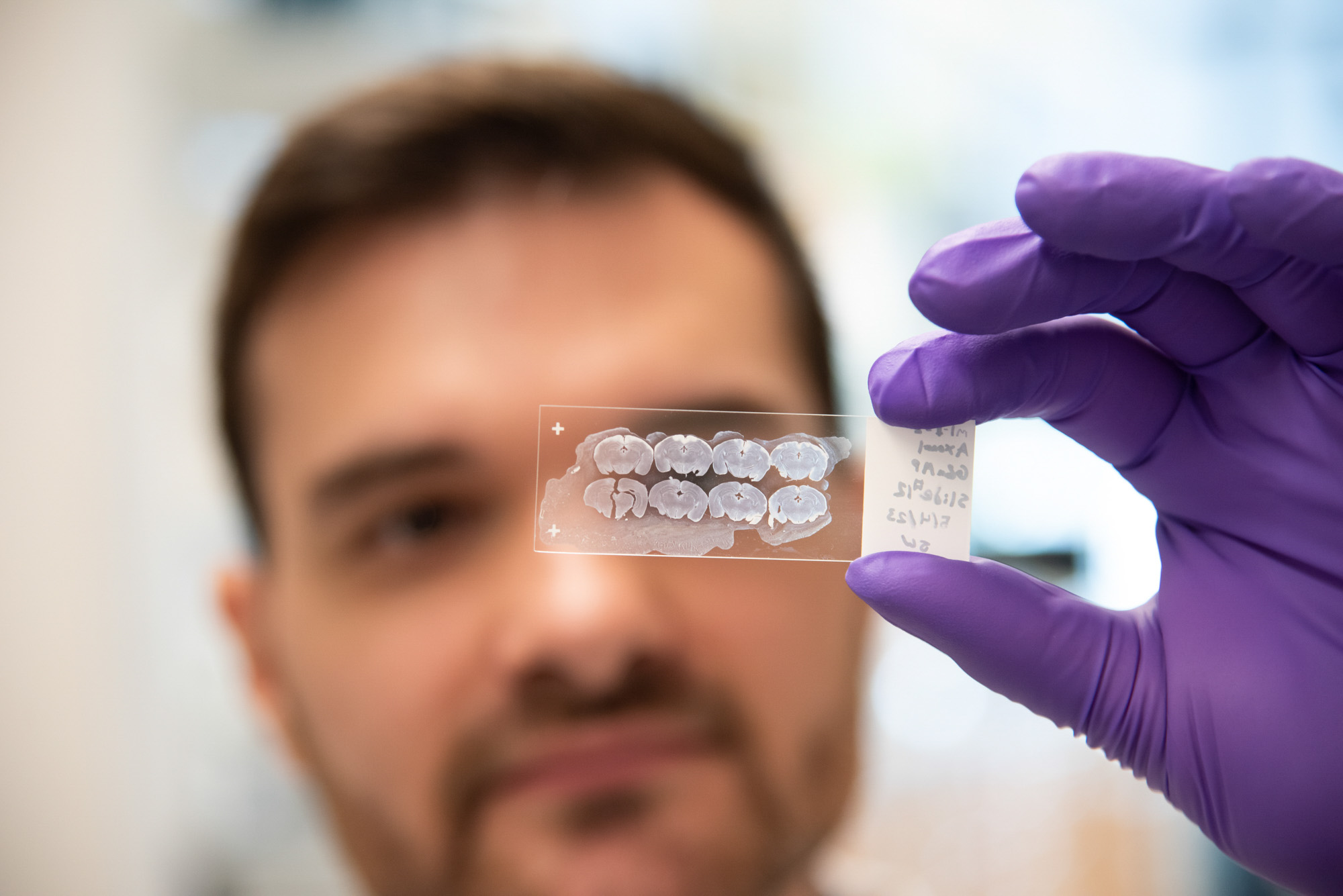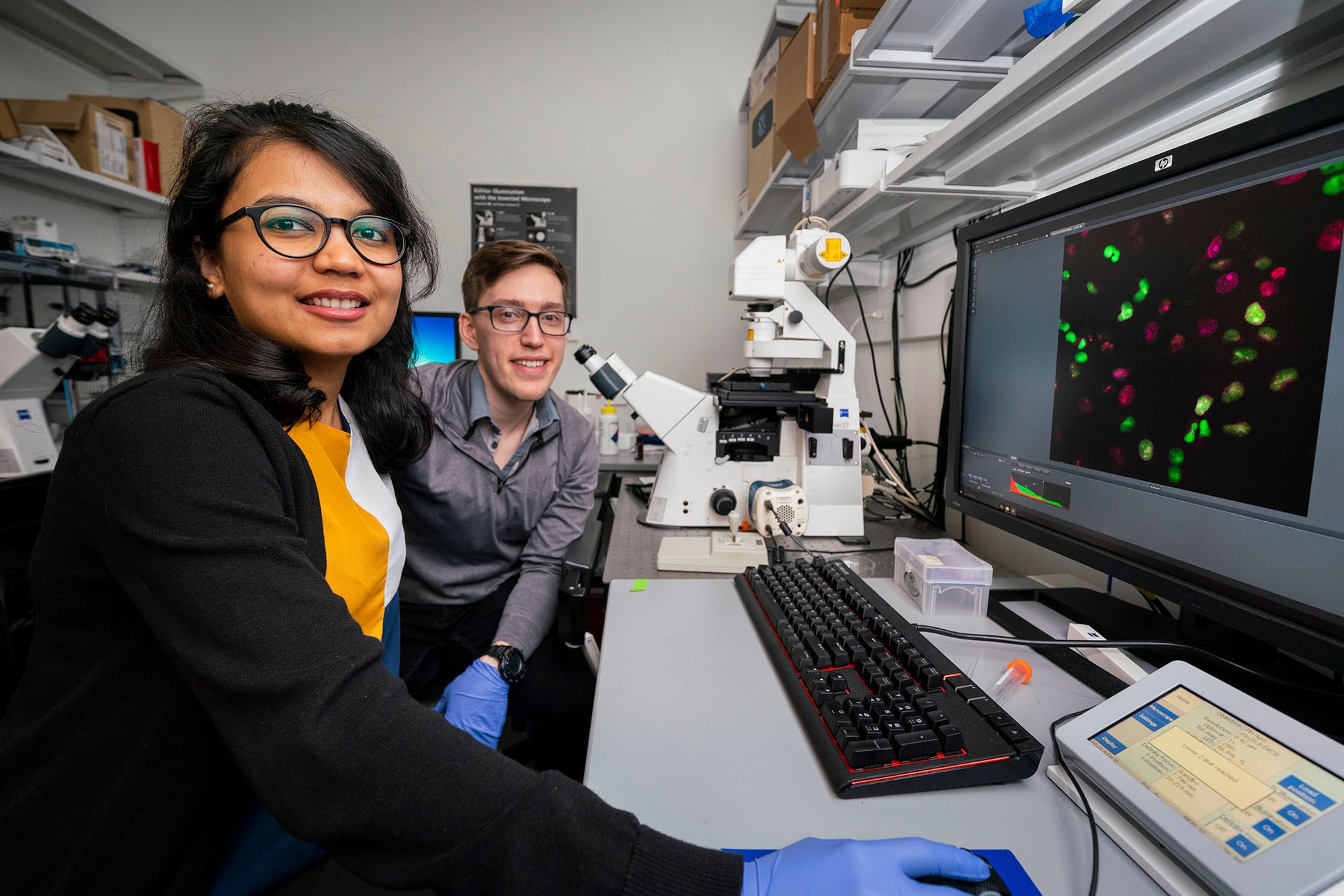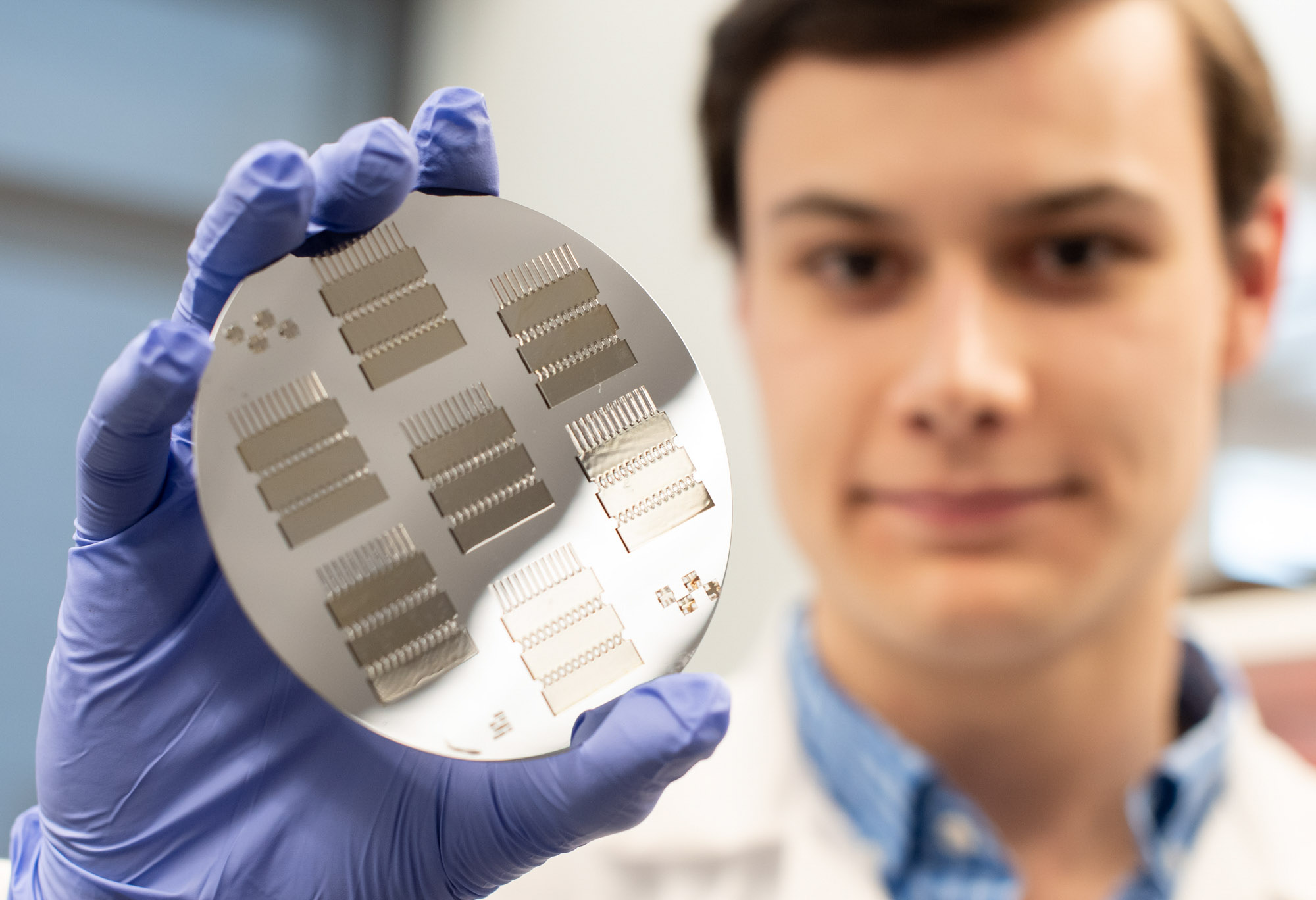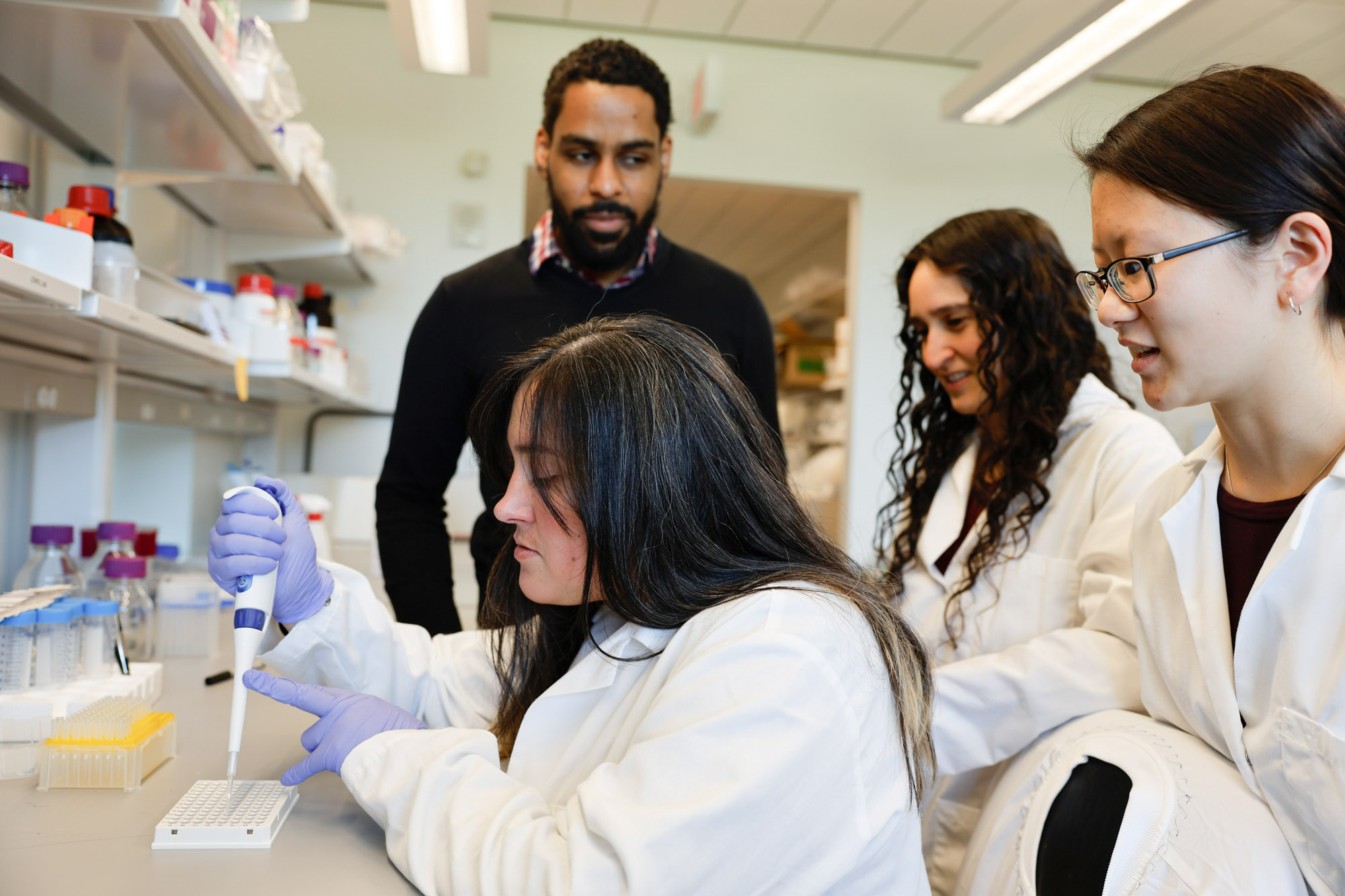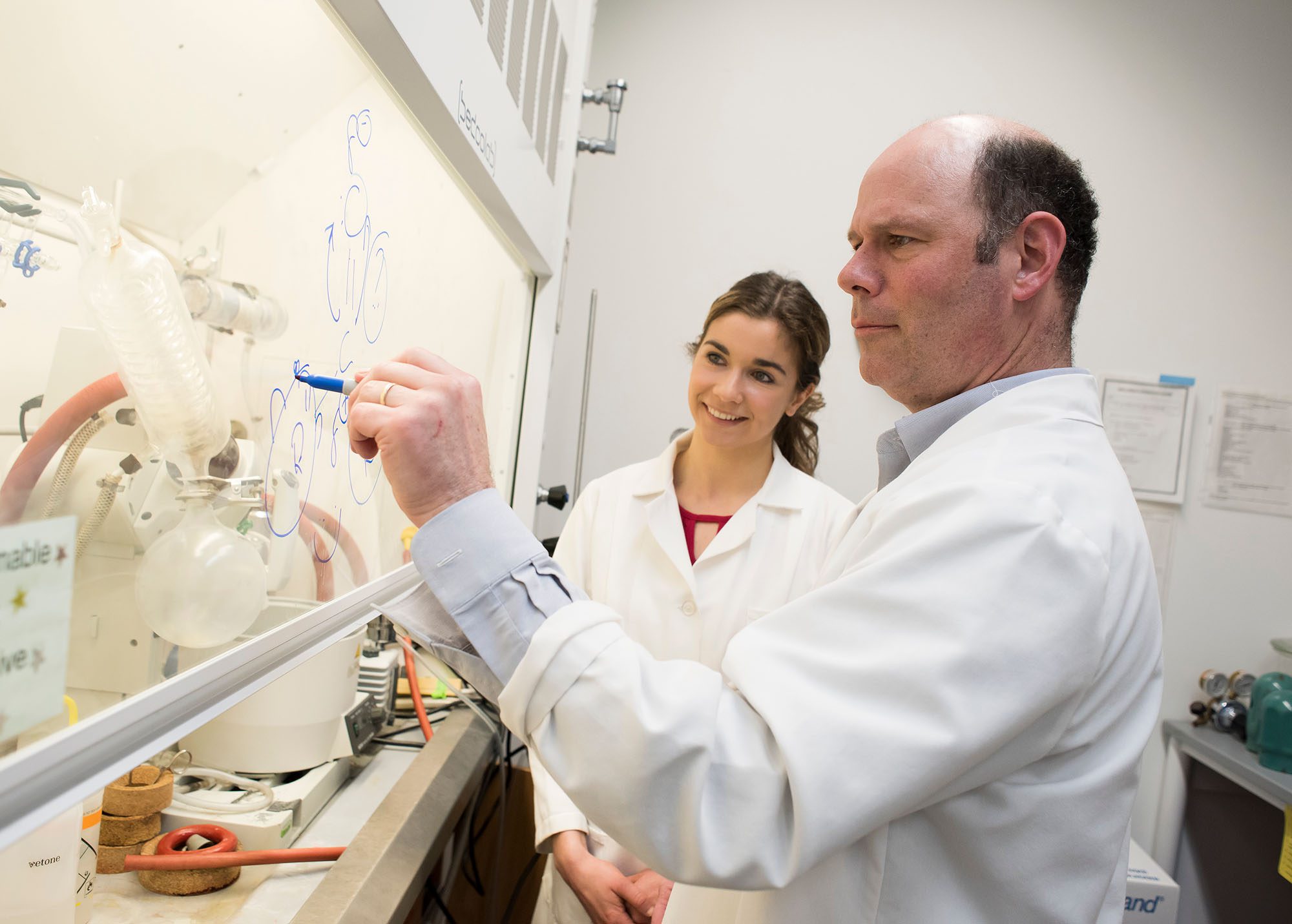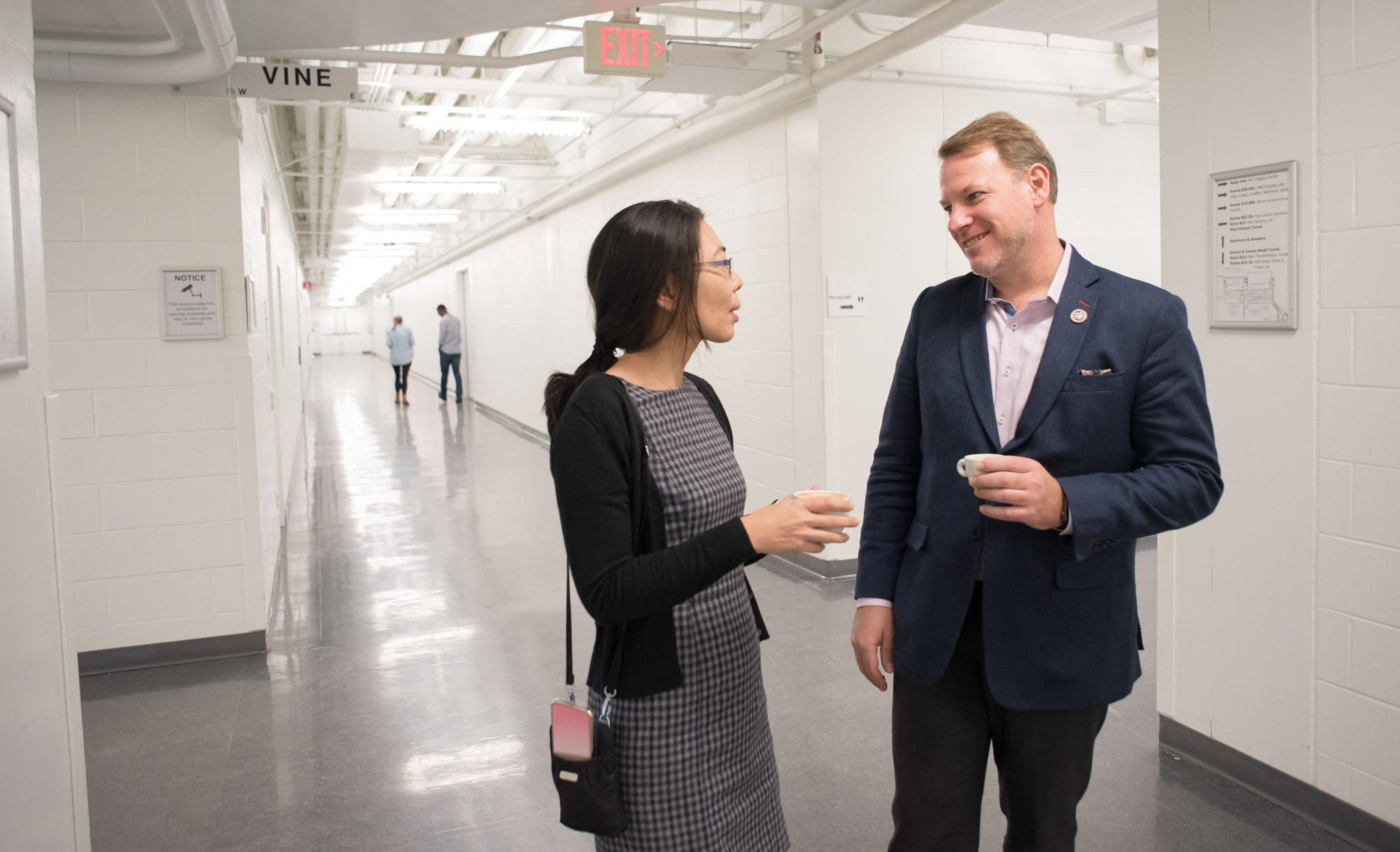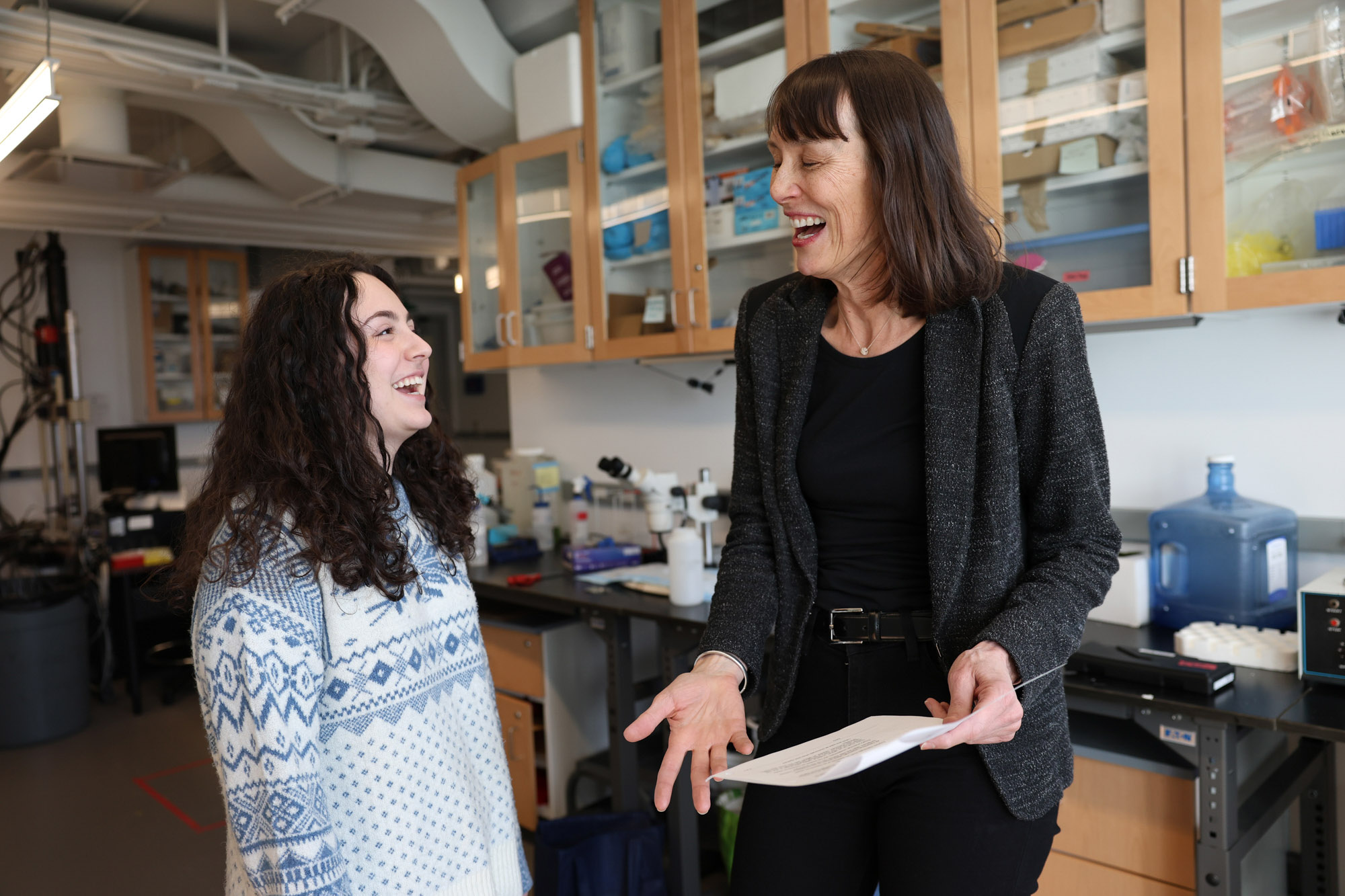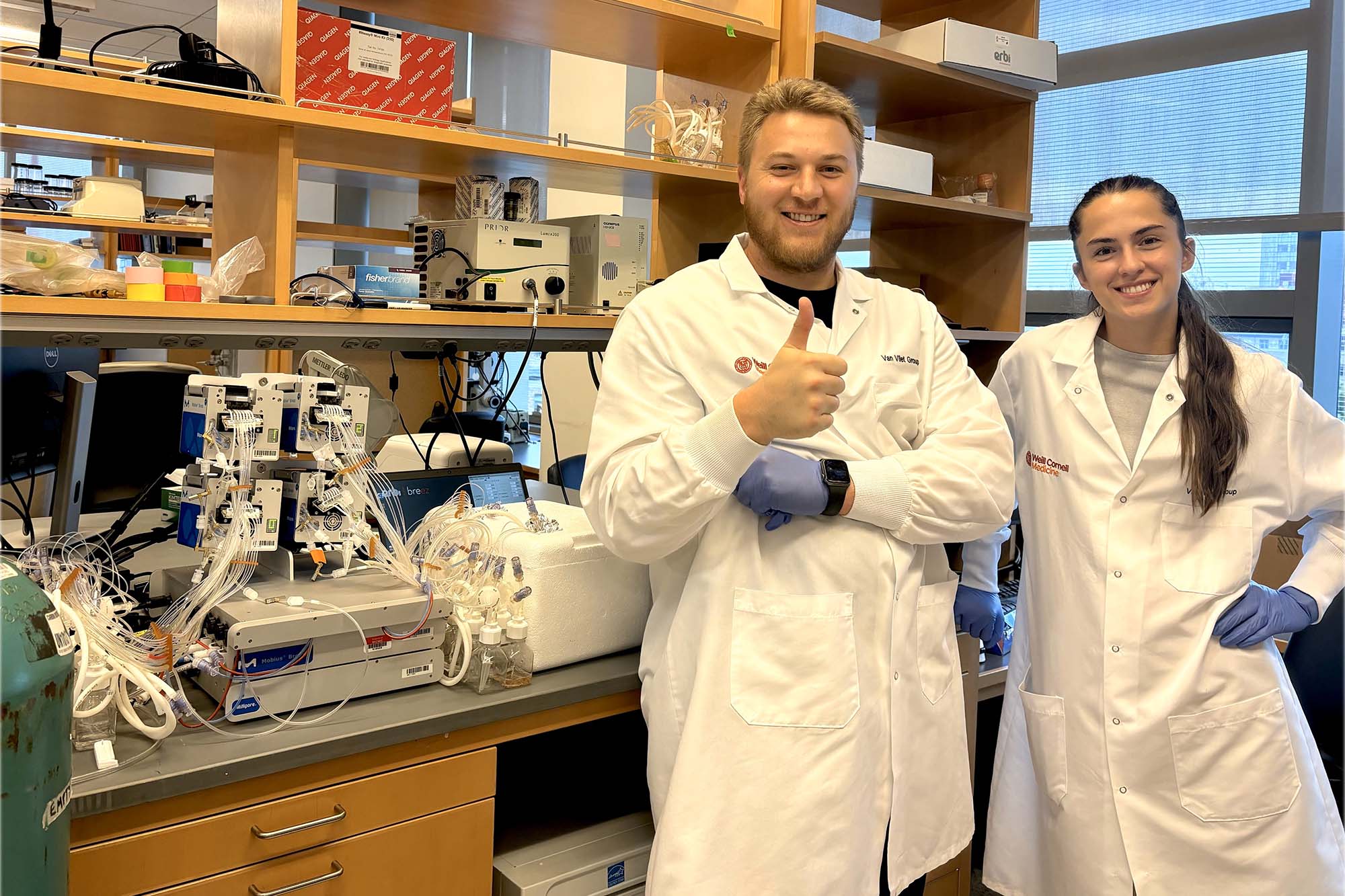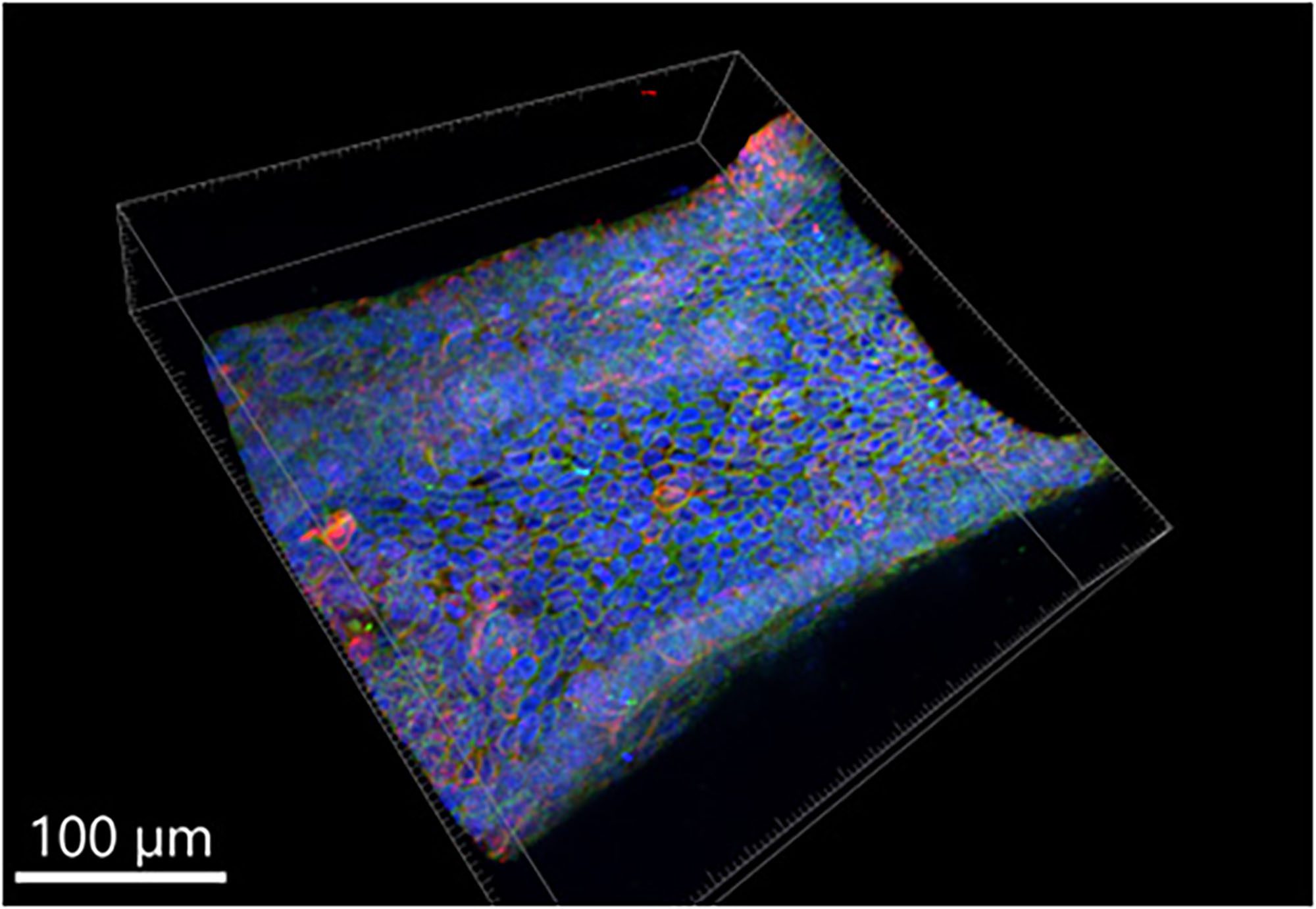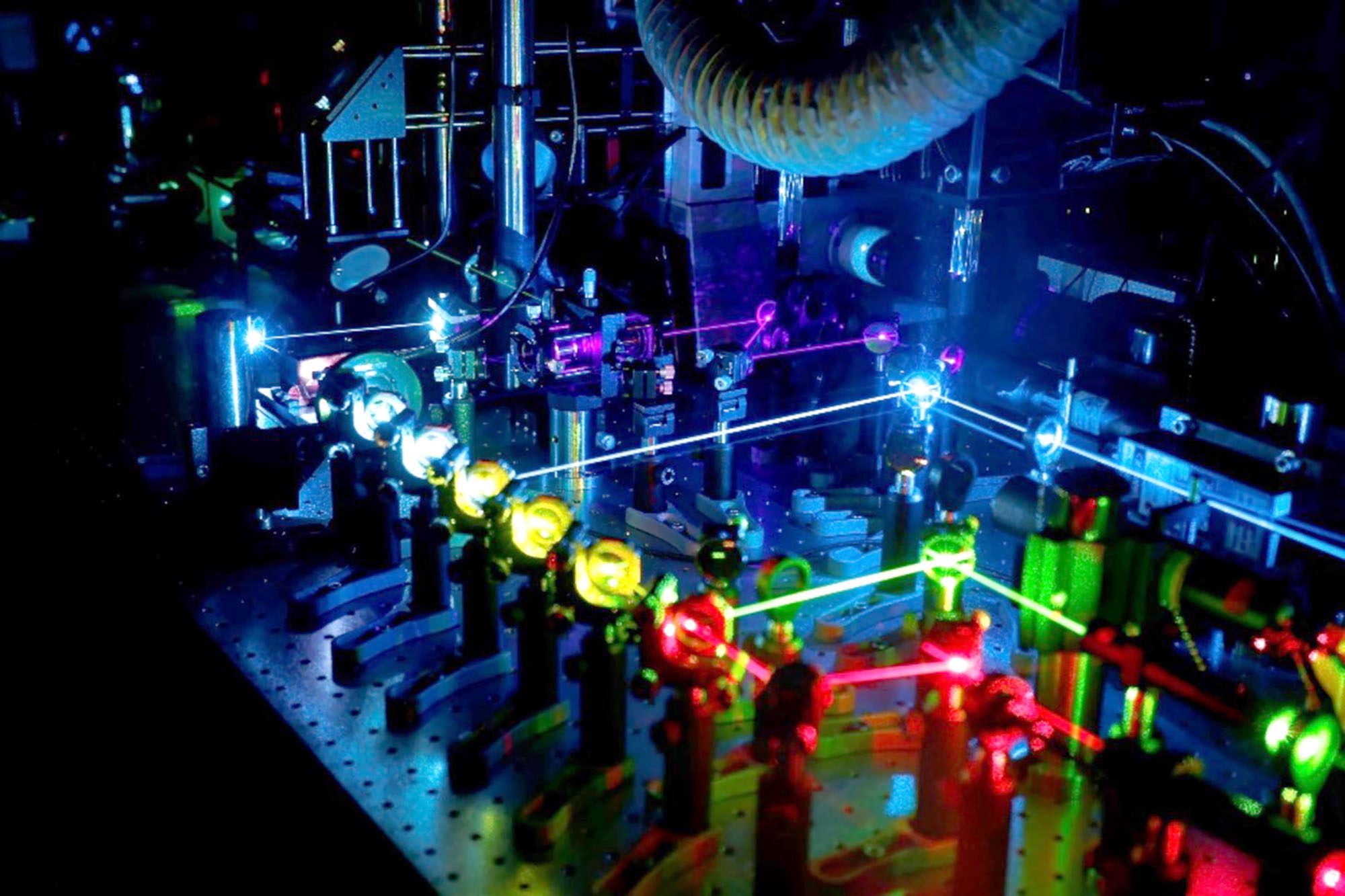-
![Professor Steve Adie watches as a student researcher conducts an experiment in the Adie lab]()
Adie Lab
The Adie Lab develops and applies new optical imaging methods for research and clinical use. Its main technique is optical coherence tomography (OCT), which offers 3D, label-free images of tissue structure and function in living subjects. It’s similar to ultrasound but provides much higher resolution.
-
![Two scientists in lab coats and safety glasses work in the Antaki lab with green laser beams illuminating the scene.]()
Antaki Lab
The Antaki Lab focuses on creating blood-wetted medical devices and how to design and use these devices in clinics. Currently, the lab is working in five areas: support systems for children’s hearts, tools for severe heart failure, home diagnostic technology, modeling blood clots in artificial systems, and devices for global health. A new project aims to boost medical innovation by connecting doctors, designers, and patients.
-
![Professor Lawrence Bonassar examines a tissue-engineered menisci sample with a graduate student wearing a white lab coat and blue gloves in the Bonassar Lab]()
Bonassar Lab
The Bonassar Lab focuses on the regeneration and analysis of musculoskeletal tissues, including bone and cartilage. The approach involves a multidisciplinary strategy using techniques in biomechanics, biomaterials, cell biology and biochemistry.
-
![A researcher wearing a white lab coat and blue gloves examines a vial in the Brito Lab]()
Brito Lab
The Brito Lab is pioneering new technologies that allow us to peer into the gut microbiomes of humans, animals and even environmental microbiomes to understand gene flow in these natural microbial communities. The lab uses experimental and computational approaches in the hope that their work will enhance our understanding of microbial ecology and inform current efforts to combat antibiotic resistance.
-
![Jonathan Butcher lab stands together in living room]()
Butcher Lab
The Butcher Lab cardiovascular developmental bioengineering laboratory studies the mechanobiological principles regulating embryonic cardiac morphogenesis and malformation. We further study how these programs are reactivated during postnatal cardiovascular disease. We translate these findings into regenerative medicine strategies for heart and valve disease.
-
![Jon Albo and Nate Cira hold up the spots liquid handling plate they developed]()
Cira Lab
The Cira Lab engages in a diverse set of efforts in quantitative biology, fluid physics and microfluidic devices.
-
![Ben Cosgrove in lab holding technology for chronic fatigue research]()
Cosgrove Lab
The Cosgrove Lab develops and utilizes systems bioengineering approaches to study the signaling network alterations underlying the decline of stem cell function and tissue regeneration in aging and disease.
-
![Iwijn De Vlaminck Lab group stands together outside Weill Hall summer.]()
De Vlaminck Lab
The De Vlaminck Lab pioneers precision measurements for biology and medicine, with a focus on profiling host-microorganism interactions. Current tools can’t measure these interactions within tissues or non-invasively in patients. We combine physics, genomics, and data science to develop new methodologies for microbiome, infectious and immune-related diseases.
-
![Peter Doershuck with researchers and dodecahedron models in Wiesner lab]()
Doerschuk Lab
The Doerschuk Lab creates and tests mathematical models for biological and medical systems with the aim to understand experimental data. The group’s projects range widely, from the study of ethanol levels in humans using breath tests to analysis of virus particle dynamics through advanced imaging. Most work involves statistical analysis. The group aims to innovate in modeling and inference while solving partners’ problems.
-
![Student holds tissue sample in tweezers above test tube in Weill Hall lab.]()
Fischbach Lab
The Fischbach Lab applies multidisciplinary strategies to gain a better qualitative and quantitative understanding of the microenvironmental conditions fundamental to the pathogenesis and therapy of cancer. The lab’s research areas include: Tumor-stroma interactions in cancer pathogenesis, tumor metastasis in engineered bone microenvironments, 3-D in vitro models of vascularized tumors and tumor angiogenesis, and engineered microenvironments to study brain cancer tumorigenesis.
-
![Illustration of zwitterionic material research]()
Jiang Lab
The Jiang Lab focuses on the understanding and development of next-generation biomaterials, particularly zwitterionic functional materials, for biomedical and engineering applications, including viral and non-virial protein and gene delivery carriers, implantable materials, stem cell cultures, blood-contact devices, biosensors and marine coatings. His research interests include immune-modulating materials, cancer immunotherapy, vaccine and immunosuppression.
-
![Student in lab holds sample slide in gloved hand.]()
Kwan Lab
The Kwan Lab applies systems neuroscience and neural engineering approaches to the study of mental health. The lab’s recent work focuses on determining the action of psychiatric drugs in the brain, using optical imaging, electrophysiological, behavioral, and molecular methods.
-
![Graduate students sit at desk with microscope and computer screen with cell imaging data]()
Lammerding Lab
Research in the Lammerding Lab is focused on “nuclear mechanobiology”, investigating how the mechanical properties of the nucleus modulate cellular functions, how physical forces acting on the nucleus affect its structure and processes, and how perturbed nuclear mechanobiology contributes to diseases such as muscular dystrophy, heart disease, and cancer. The multidisciplinary research approach combines the development of novel experimental assays with cell and molecular biology techniques and preclinical models, with the ultimate goal to develop novel therapeutic strategies for diseases linked to altered nuclear mechanobiology.
-
![A researcher in the Esak Lee lab wearing a white lab coat and purple gloves holding a device.]()
Lee Lab
The Lee Laboratory develops and engineers the three-dimensional (3D) microphysiological systems (MPS) of human lymphatics to better understand lymphatic functions and dysfunction and provide new therapeutic strategies to treat lymphatic-related human diseases, including lymphedema, neurological disease (brains and eyes), immune disorder and cancer.
-
![Professor Karl Lewis and two students in white lab coats watch as a third student in a white lab coat with purple gloves conducts an experiment in the Lewis lab.]()
Lewis Lab
The Lewis Lab develops advanced imaging techniques to study the fundamental mechanisms that regulate bone health and adaptation. Their work explores how bones interact with other tissues, uncovering critical insights into the biological “cross-talk” that drives skeletal maintenance and repair. By accessing new dimensions of bone biology, the lab aims to inform innovative strategies for preventing and treating diseases like osteoporosis.
-
![David Putnam with graduate student, wearing lab coats and writing chemical formulas on fume hood glass in lab]()
Putnam Lab
The Putnam Lab applies chemistry and microbiology techniques to create functional biomaterials for applications in drug delivery, vaccines, and surgical applications.
-
![Professors Nozomi Nishimura and Chris Schaffer hold coffee cups while talking in the hallway outside the Schaffer-Nishimura lab.]()
Schaffer-Nishimura Lab
The Schaffer-Nishimura Lab focuses on the use of nonlinear optical interactions between femtosecond-duration laser pulses and biological material as a tool for precise ablation of structures and quantitative observation of dynamical processes in live biological samples. These approaches are used to elucidate the cellular mechanisms contributing to disease symptoms in mouse models of neurodegenerative and cardiovascular disease.
-
![Professor Marjolein Van Der Meulen and a student laugh in the lab.]()
van der Meulen Lab
Orthopaedic biomechanics research in the van der Meulen Lab focuses on musculoskeletal mechanobiology and bone biomechanics. Recent studies focused on the responses of joint tissues to mechanical loading in normal and diseased conditions.
-
![Van Vliet lab students in lab coats smiling and thumbs up.]()
Van Vliet Lab
The Van Vliet Group specializes in material chemomechanics — the coupling between chemistry and mechanics at material interfaces. Their research leverages the perspectives of materials physics to develop innovative materials and methods for cell therapy manufacturing and drug discovery.
-
![A student wearing a blue lab coat and blue gloves holds an experiment in the Yadong Wang lab]()
Yadong Wang Lab
The Wang Lab focuses on biomaterials. It designs materials that influence cells, tissues, and organs. The aim is to control the body’s response to these materials. The lab targets applications in the cardiovascular, nervous, and musculoskeletal systems. It welcomes collaborations with scientists and doctors in translational research. Current projects include vascular grafts, protein release systems, and biomaterial microfabrication.
-
![Undergraduate students in active learning class working in groups]()
Werth Lab
The Werth Lab focuses on Engineering Education Research (EER), a branch of discipline-based education research (DBER) that examines the unique educational aspects within engineering contexts. In particular, we develop evidence-based teaching methodologies and educational tools to more equitably foster authentic learning environments.
-
![3D reconstruction of one wall of a cylindrical channel of a perfusable kidney collecting duct on-chip derived from patient cells]()
Wolf Lab
The Wolf Laboratory addresses clinical needs in kidney and women’s reproductive health by developing models of urogenital tract tissues and investigating biophysical forces that direct tissue function. This work integrates multiple research areas such as mechanobiology, biofabrication and soft matter design.
-
![Warren Zipfel lab super resolution microscope lasers]()
Zipfel Lab
The Zipfel Lab creates advanced tools and methods for research in biophysics, biology, and medicine, collaborating with others to study cancer, nuclear structure, chromatin, gene interactions, and protein functions. The lab’s work spans biochemistry, molecular biology, photophysical analysis, optical and electronic design, and C/C++ software development for data analysis, instrument control, and image processing.
Research Groups

